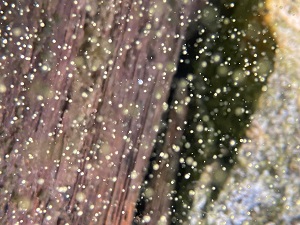Cyanobacteria
Contact
Cyanobacteria Sightings Reported - Gloeotrichia
 A few New Hampshire lakes (including Lake Winnipesaukee, Lake Wentworth and Lake Sunapee) have been found to contain a unique cyanobacteria taxa called Gloeotrichia. Each colony of Gloeotrichia may contain approximately 5,000 cells. The colonies look like very small, fuzzy balls in the water. They can appear either green or sometimes brownish-yellow by eye. Oftentimes, these cyanobacteria do not accumulate to large concentrations and may go unnoticed. These types of cyanobacteria do not typically form green surface scums, however they can quickly accumulate along shorelines and coves. The water may appear cloudy in areas of higher concentrations.
A few New Hampshire lakes (including Lake Winnipesaukee, Lake Wentworth and Lake Sunapee) have been found to contain a unique cyanobacteria taxa called Gloeotrichia. Each colony of Gloeotrichia may contain approximately 5,000 cells. The colonies look like very small, fuzzy balls in the water. They can appear either green or sometimes brownish-yellow by eye. Oftentimes, these cyanobacteria do not accumulate to large concentrations and may go unnoticed. These types of cyanobacteria do not typically form green surface scums, however they can quickly accumulate along shorelines and coves. The water may appear cloudy in areas of higher concentrations.
Surface blooms can rapidly change and accumulate in various locations around a waterbody. Please continue to monitor your individual shorelines for changing conditions and avoid contact with cyanobacteria bloom accumulations.
Cyanobacteria are natural components of water bodies worldwide, though blooms and surface scums may form when excess nutrients are available to the water. Some cyanobacteria produce toxins that are stored within the cells and released upon cell death. Toxins can cause both acute and chronic health effects that range in severity. Acute health effects include irritation of skin and mucous membranes, tingling, numbness, nausea, vomiting, seizures and diarrhea. Chronic effects may include liver and central nervous system damage. Be cautious of lake water that has a surface scum, changes colors, appears cloudy or has green streaks or blue-green flecks.
New Hampshire researchers are studying Gloeotrichia cyanobacteria. To learn more, please visit:
- Dartmouth Gloeotrichia Project
- Lake Sunapee Protective Association
- UNH Center for Freshwater Biology
Visit the NHDES Beach Program website for photos and more information about cyanobacteria.
View updates on cyanobacteria advisories.
Follow the Beaches twitter feed.
If you notice anything resembling cyanobacteria, please refrain from wading, swimming, or drinking the water. Keep all pets out of the water and contact NHDES immediately. Please call NHDES to report a cyanobacteria bloom at (603) 848-8094 or email HAB@des.nh.gov.




